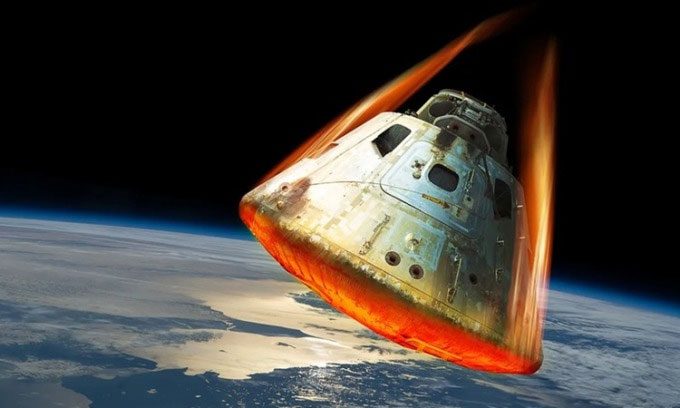The mission to transport humans to the Moon, Apollo 11, might not have concluded successfully as expected if a collision occurred between the two modules of the spacecraft.
More than 50 years ago, Apollo 11 was an incredibly successful mission for the United States, as NASA transported humans to the lunar surface for the first time and safely brought them back home. However, this historic mission nearly ended in tragedy during the re-entry phase. An issue arose just before the Apollo 11 crew returned to Earth, nearly causing one module to collide with the astronaut transport module, according to Business Insider.

Simulation of the spacecraft module returning to Earth. (Photo: Marc Kard).
The malfunction occurred less than an hour before the Apollo 11 mission’s landing. For most of the 8-day mission, the astronauts were inside a conical capsule known as the command module. This module sits above the service module, a large cylinder that contains supplies, propellant, and rocket engines. NASA refers to these two spacecraft components as the Command and Service Module (CSM).
The CSM carried a third module called the Lunar Module into orbit around the Moon. The Lunar Module then transported Buzz Aldrin and Neil Armstrong to the lunar surface and back to the spacecraft, while astronaut Michael Collins remained in lunar orbit. The CSM then fired its rocket engine to carry the trio back to Earth on a 3-day journey. About 15 minutes before the astronauts landed in the Pacific Ocean, the CSM separated into two parts. This operation was crucial, as only the command module containing the crew had a heat shield. The heat shield protected the astronauts by redirecting and absorbing the energy generated while traveling through the atmosphere at 40,234 km/h, which is tens of times faster than a bullet.
The service module became useless and posed a collision risk after the two parts separated; therefore, it was programmed to break away in Earth’s atmosphere like a stone thrown across a pond. However, this process did not unfold as planned. Instead, the service module fell alongside the astronaut transport module.
“Houston, we see the service module flying close to the upper right,” Aldrin reported to mission control via radio. “It’s flying from right to left.”
Due to plasma buildup in front of the capsule, radio communication was temporarily interrupted, preventing the astronauts from providing further details. However, a pilot flying nearby observed both the command module and the service module returning to Earth. The service module broke apart into several flaming pieces.
Gary Johnson, an electrical engineer who worked on the Apollo program, shared that the service module should not have fallen near the command module. If it had collided with the crew-carrying command module, that component could have destroyed or caused the spacecraft to lose control. Debris from the service module could also have struck the command module, leading to disaster. “If the situation had worsened, the Apollo 11 crew could have lost their lives. We were very fortunate,” he said.
The astronauts, controllers, and communication staff were unaware of the issue until NASA interviewed the three astronauts about the mission a few weeks later. NASA conducted an investigation based on their reports and discovered that two previous missions, Apollo 8 and Apollo 10, had encountered similar problems. However, the other astronauts did not see the service module outside their window, so they did not report any issues. A review of radar data indicated that the service module in those missions also flew too close to the command module.
The cause of the problem was a series of maneuvers in the control system responsible for separating the command and service modules. NASA was aware of the same issue existing on the Apollo 12 spacecraft, launched in November 1969, but decided not to fix it due to time constraints.




















































